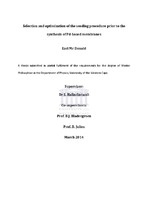| dc.contributor.advisor | Halindintwali, S. | |
| dc.contributor.advisor | Bladergroen, B.J. | |
| dc.contributor.advisor | Julies, B. | |
| dc.contributor.author | Mc Donald, Earl | |
| dc.date.accessioned | 2015-05-04T09:52:52Z | |
| dc.date.available | 2015-05-04T09:52:52Z | |
| dc.date.issued | 2014 | |
| dc.identifier.uri | http://hdl.handle.net/11394/4102 | |
| dc.description | Magister Philosophiae - MPhil | en_US |
| dc.description.abstract | Pd based membranes are known for their incredible selectivity towards H2. In order for Pd membranes to display high H2 selectivity, a defect free layer of Pd needs to be deposited onto a support. Although various fabrication techniques do exist, many researchers have attempted to produce defect free Pd-based films, using electroless plating. The first step in the preparation technique involves “seeding” of the support structure. Even though these seeds, if well distributed and anchored to the support, are crucial in order to obtain the defect free Pd layer, they hardly ever received attention from the science community. This thesis reports findings on various seeding methods as well as the resulting microstructures of the Pd films formed as a result of the type of seeding method employed. Finally the quality of the membranes using the most promising seeding technique was determined by subjecting the membranes to permeance tests with N2 at both high and low temperatures as well as with H2 at high temperatures. | en_US |
| dc.language.iso | en | en_US |
| dc.publisher | University of the Western Cape | en_US |
| dc.subject | Electroless plating | en_US |
| dc.subject | Seeding methods | en_US |
| dc.subject | Pd-based membranes | en_US |
| dc.title | Selection and optimization of the seeding procedure prior to the synthesis of Pd-based membranes | en_US |
| dc.type | Thesis | en_US |
| dc.rights.holder | University of the Western Cape | en_US |

